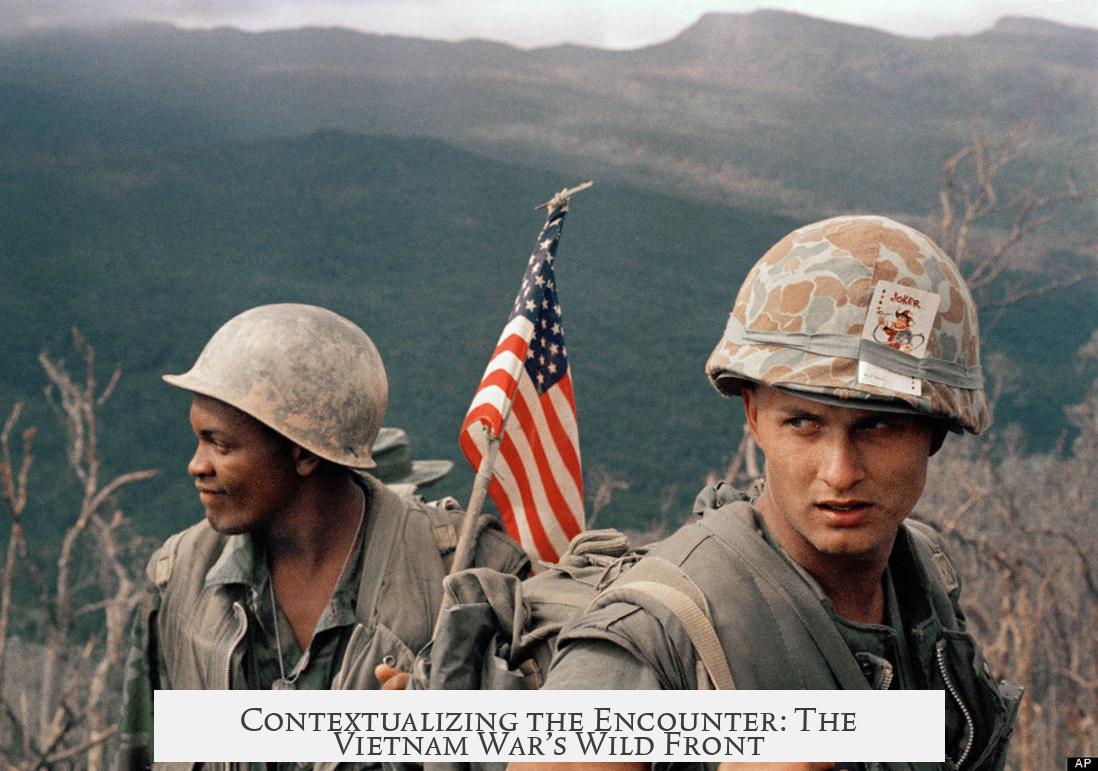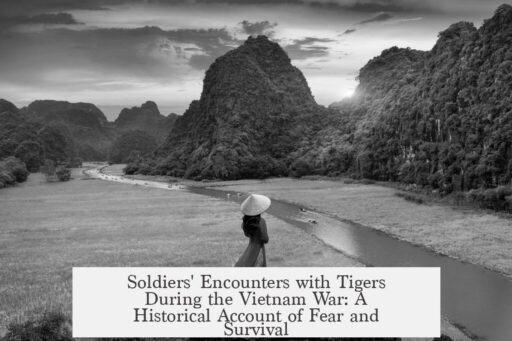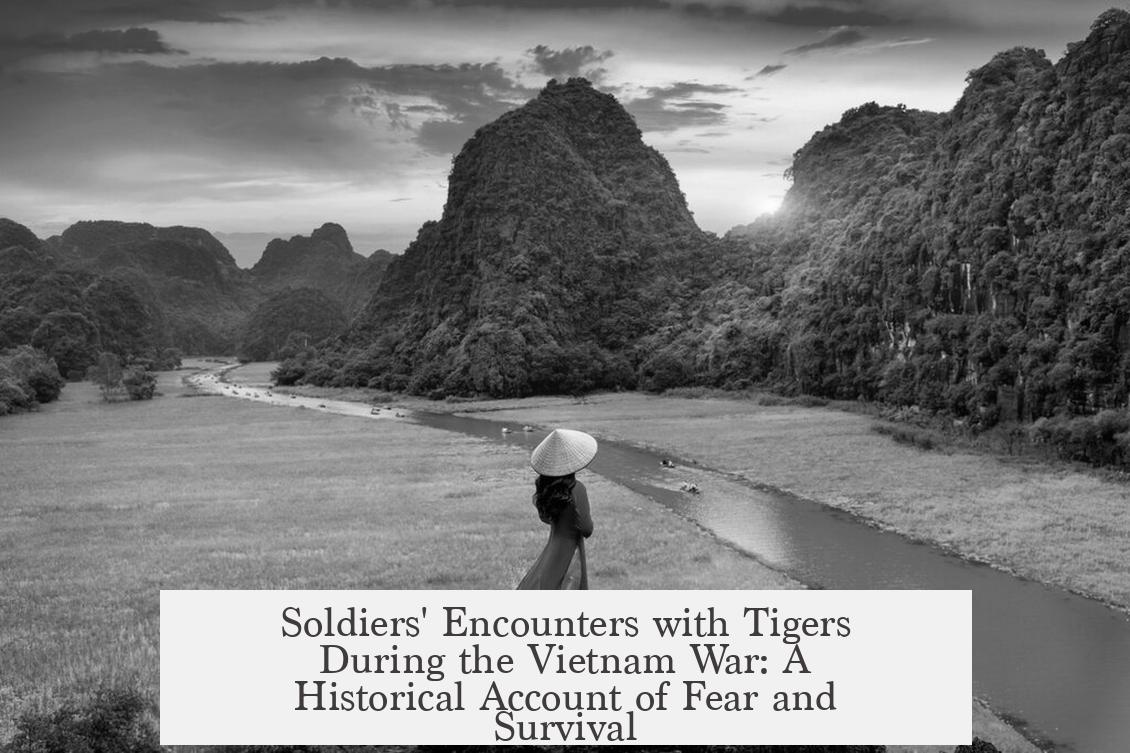Yes, there is a verified account of soldiers encountering tigers during the Vietnam War. On December 22, 1968, a 400-pound, nine-foot tiger attacked a six-man Marine reconnaissance patrol from the 3rd Marine Reconnaissance Battalion near Fire Support Base Alpine in Quang Tri, South Vietnam.
The patrol had completed its mission and was waiting for helicopter extraction when the tiger attacked silently and swiftly. Sgt. Goolden, one of the Marines, was the target and was dragged into a nearby bomb crater by the tiger. The remaining Marines immediately responded by pursuing the tiger and opening fire, ultimately killing the animal and rescuing Sgt. Goolden.
After the attack, Sgt. Goolden showed signs of being dazed and was found with lacerations and bite wounds, particularly on his neck. He received first aid on site and was evacuated by Marine CH-46 helicopter to the 3rd Medical Battalion Hospital in Quang Tri for further treatment.
The dead tiger was transported to the 3rd Reconnaissance Battalion headquarters, where it was publicly displayed on a 10-foot scaffold outside Charlie Company’s administration office. The tiger was inspected by senior military officials, including Major General Raymond G. Davis and Brigadier General Robert B. Carney, Jr., who commended the team for their actions.
| Detail | Description |
|---|---|
| Date | December 22, 1968 |
| Location | Fire Support Base Alpine, Quang Tri, South Vietnam |
| Unit | 3rd Marine Reconnaissance Battalion |
| Tiger Size | 400 pounds, 9 feet long |
| Victim | Sgt. Goolden (injured) |
| Casualties | One injured Marine; tiger killed |
This incident was not isolated. Prior to this attack, a man-eating tiger killed a Marine around November 12, 1968, near the demilitarized zone about ten miles south of where the later attack occurred. Military authorities had dispatched a Marine contingent alongside two South Vietnamese tiger hunters to track the predator and others in the area. The mission to locate the tiger failed, illustrating the dangerous wildlife conditions in the region during the war period.
First-person accounts from Marines present at the scene provide detailed descriptions of the event. For instance, Private First Class Thomas E. Shainline heard screams and immediate shouts warning of the tiger. PFC Roy Regan vividly recalled the tiger attacking his companion and the subsequent struggle. The team’s quick reaction—including opening fire and calling for medical evacuation—saved Sgt. Goolden’s life.
The incident is backed by multiple sources, including military records and testimonies, confirming that encounters with dangerous wildlife, including tigers, were a real hazard for troops operating in Vietnam’s jungles. The attack by such a large man-eating tiger is one of the documented cases and highlights the unpredictable environment soldiers faced in addition to combat dangers.
The story also shows the military’s respect for the severity of the threat. The tiger’s body was displayed prominently—demonstrating the significance of the event to the troops. Senior military leaders personally acknowledged the team’s actions, underscoring the rarity and seriousness of tiger attacks during the Vietnam War.
- A 400-pound tiger attacked a Marine recon patrol on December 22, 1968, in Quang Tri.
- The patrol was completing a mission and awaiting extraction when the attack occurred.
- Sgt. Goolden was injured but survived after the team killed the tiger.
- This tiger had previously killed a Marine about a month earlier near the DMZ.
- Military and tiger hunts took place but failed to locate the predator before this attack.
- The tiger’s body was displayed at battalion headquarters and examined by high-ranking officers.
- The accounts are supported by firsthand testimonies and official military records.
Encounters with large predatory animals like tigers add a notable dimension to the hazards Vietnam War soldiers faced. This confirmed event reveals the complexity of jungle warfare and the diverse threats troops had to overcome beyond enemy combatants.
Are There Any Accounts of Soldiers Encountering Tigers During the Vietnam War?

Indeed, there is a confirmed and well-documented encounter between soldiers and a tiger during the Vietnam War. On December 22, 1968, a striking and harrowing incident unfolded near Fire Support Base Alpine in Quang Tri Province, involving a 400-pound, nine-foot tiger attacking a six-man Marine reconnaissance patrol. This rare but terrifying event sheds light on the unexpected wildlife dangers soldiers faced beyond enemy combatants in Vietnam’s dense jungles.
Let’s dive into this extraordinary encounter and uncover the details, the soldier’s experience, and the aftermath. You might be surprised how nature intruded into the gritty war zone and what it meant for those involved.
The December 22, 1968 Tiger Attack: Where and Who?
This encounter happened near Fire Support Base Alpine, a tough spot about six miles east of the Laotian border in northwestern South Vietnam. The unit involved was the 3rd Marine Reconnaissance Battalion. Their mission had just finished, and they were waiting for a helicopter pickup when the unexpected visitor arrived.
Picture this: after a grueling patrol, the six Marines are catching their breath, some catching a few winks, while two are manning the radio watch. Suddenly, a tiger strikes—silent, swift, and lethal.
The Attack Unfolds: A Moment Frozen in Time
“Suddenly I heard somebody scream,” PFC Thomas E. Shainline recalls, “then somebody else was yelling, ‘it’s a tiger, it’s a tiger!'”
PFC Roy Regan jumped up and saw the tiger with its mouth around his partner, Sgt. Goolden.
The tiger did not just appear out of nowhere—it attacked Sgt. Goolden silently and swiftly. It grabbed him and leapt into a bomb crater about 10 meters away, gripping him like a prize. The other Marines reacted fast, chasing the beast to the crater and opening fire. Once hit, the tiger released Sgt. Goolden, who staggered out injured but alive.
Think about that: a massive predator, nine feet from nose to tail, and 400 pounds of muscle crashing into a squad of Marines. The team’s quick response arguably saved Sgt. Goolden’s life. Tactical training may prepare soldiers to handle enemy fire, but handling a predatory tiger? That’s battlefield improvisation at its finest.
Medical Aftermath and Military Recognition

Despite the adrenaline and immediate combat mindset, the wounded Marine was treated quickly. He suffered multiple lacerations and bites around his neck, necessitating urgent first aid and a helicopter evacuation to the 3rd Medical Battalion Hospital in Quang Tri.
Meanwhile, the dead tiger was transported back to the 3rd Reconnaissance Battalion headquarters. There, the massive beast was displayed on a 10-foot scaffold outside Charlie Company’s administrative office. High-ranking officers, including Major General Raymond G. Davis and Brigadier General Robert B. Carney Jr., personally inspected the animal and commended the patrol for their swift and effective action.
Was This Tiger a Lone Predator or Part of a Bigger Danger?
Interestingly, this man-eating tiger wasn’t new to the area or the military’s concerns. Records show that about a month before the December attack, a Marine was killed by what was believed to be the same tiger around ten miles south of the demilitarized zone (DMZ).
The military even sent a special contingent of Marines along with two professional South Vietnamese tiger hunters to track down this rogue tiger and other potential threats in the region. Despite the hunt, they failed to find the animal, allowing the threat to persist until the fatal encounter on December 22.
This raises some critical questions about wartime dangers. Soldiers obviously prepared for enemy combatants but what about Mother Nature’s lurking perils? Tigers, snakes, diseases, and unforgiving terrain were all silent threats that added a brutal layer of survival challenges.
A Soldier’s Perspective: Cpl. Dennis M. Soldner’s First-Person Account
Cpl. Dennis M. Soldner, a team member during that harrowing day, offers a detailed recollection. He confirms the timeline and vivid details—the completion of the mission, waiting for pickup, bad weather delaying extraction, the two-man radio watch, and the tiger’s sudden strike on Sgt. Goolden.
Cpl. Soldner describes the team’s immediate response, the first aid applied, the eventual evacuation, and the solemn display of the massive predator post-attack. He also notes the recognition and congratulations from senior officers.
This WWII vet’s eyewitness details enrich the story with authenticity and bring a human perspective to an otherwise rare and harrowing encounter.
Contextualizing the Encounter: The Vietnam War’s Wild Front

While combat stories often highlight firefights and tactical maneuvers, nature’s impact sometimes slips through the cracks. Soldiers dealing with hostile environments had to contend with predatory animals like tigers, which were legitimate threats in the jungles of Southeast Asia.
This particular incident reminds us that the Vietnam War was fought on multiple fronts: not just against enemy combatants, but against disease, insects, wildlife, and environmental hardships.
How did soldiers prepare for wildlife encounters? Mostly through sharp awareness, keeping camps secure, and moving quickly. But not every threat was predictable. For the 3rd Marine Recon patrol, this tiger attack was sudden and deadly.
What Can We Learn From This Tiger Encounter?
- Survival Requires Adaptability: Soldiers had to switch from war tactics to survival instincts instantly.
- Natural Hazards Persist in War Zones: Beyond bullets and bombs, soldiers face unpredictable dangers like predatory animals.
- Teamwork and Preparedness Matter: The quick action of the recon patrol was critical for survival.
- Wildlife Management During War: Attempts to track and eliminate the rogue tiger show that military operations sometimes extend beyond enemy combat.
Modern armies could still take lessons here about soldiers’ vulnerability to environmental threats in unfamiliar territories.
Wrapping Up: The Tiger’s Legacy in Vietnam War History
Yes, accounts of soldiers encountering tigers during the Vietnam War are rare but real. The December 22, 1968 attack remains the most notable incident, supported by multiple eyewitness accounts, military reports, and newspaper articles. This story is a sobering reminder that sometimes, the wilderness itself becomes an unexpected opponent.
Have you ever thought about how often nature intersects with human conflict? This incident begs the question: how many untold stories exist where soldiers fought not only a human enemy but also the animal kingdom’s fiercest predators?
Next time the Vietnam War comes up, remember this: between bullets and booby traps, a silent, massive tiger stalked the shadows—and a group of Marines survived one of the jungle’s deadliest encounters.




